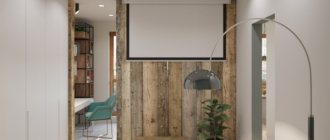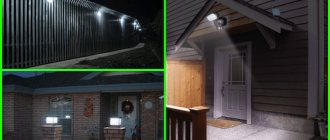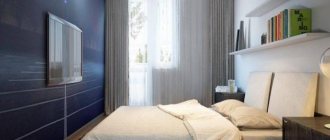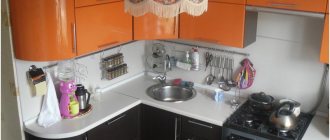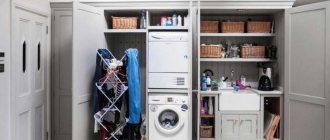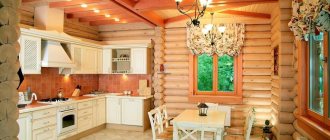A separate room for storing clothes is gradually ceasing to be an attribute of luxury and the prerogative of a large private home. So, for example, in a city apartment you can organize a small dressing room from the pantry - this will save space in other rooms, will cost less than a custom-made wardrobe and will allow you to organize convenient storage of things. In this article we tell you how to do it yourself step by step.
No. 1. Is there a need for a dressing room?
Surely, almost every girl dreams of a separate room where numerous pairs of shoes would be neatly arranged and beautiful outfits hung. Going to such a room to choose clothes suitable for a particular occasion would turn into a whole ritual with mandatory fitting. Often such a dream remains a dream, because it encounters criticism. Why do you need a separate dressing room in a small apartment when all your things can be hidden in a spacious wardrobe? It would seem that everything is correct, but part of the family wardrobe will still be stored in small closets throughout the apartment, and all outerwear and most shoes will be stored in the hallway. The usual arrangement of things, in which space is not saved at all.
A dressing room, albeit small, gives its owners a lot of advantages:
- the opportunity to get rid of bulky cabinets, chests of drawers, shelves, bedside tables and hooks dispersed throughout the apartment. This will make the home more neat and free, and visually it will be perceived even more;
- Finding the necessary item in a dressing room with open shelving and rods is much easier than rummaging through an often dark closet with narrow shelves;
- the opportunity to make the most of the dressing room space by building shelves up to the ceiling and combining different storage areas at your discretion. Even a small dressing room can accommodate more things than a wardrobe;
- wardrobe items that are neatly folded on shelves or hanging freely on a rod retain their original appearance much longer. Of course, this advantage is also typical for a large wardrobe with thoughtful filling, but often in wardrobes clothes are folded too tightly.
The main difficulty that you will have to face on the way to creating a dressing room is finding a suitable place and separating it. Of course, the construction of the partition will take up some of the usable space, but upon closer comparison it turns out that having a separate dressing room, especially if family members have a lot of things, is still more profitable. Modern storage systems allow you to create a convenient dressing room even for 2-3 m2. The minimum possible area of a dressing room is 1.2-1.5 m2.
Why white?
And not blue or, for example, pink? Because it is the white color that has always been and remains in trend: it can be completely different - strict classic, stylish for youth, and business-appropriate. Pure white and its shades are becoming increasingly popular in wardrobe color schemes offered by various world-famous manufacturers.
Both the visual perception of a person and his psychology are at work here: against the background, for example, of some pastel or brighter colors of the dressing room, many things can lose their attractiveness, can look completely unattractive and for this reason risk waiting for their finest hour on the hanger for a long time.
Some people see in white only facelessness, snowy coldness and neutrality. But when decorating a dressing room, neutrality is exactly what is needed: only in this case the color scheme of clothing items will not be blurred, and all the attention of the dressing room owner will be concentrated exclusively on blouses, blouses, skirts and dresses, as well as shoes and boots to go with them. White color is a powerful means of expression, unobtrusively receding into the background and favorably shading clothes and shoes on hangers and shelves.
No. 2. Choosing a place for a dressing room
To find a place for a small dressing room, we analyze all areas and corners of the apartment. The potential and most successful places for a dressing room are:
- pantry. There are no comments at all. In many apartments the project includes a small utility room. If you didn’t get rid of it at the time, then converting it into a dressing room is not difficult. A pantry and a dressing room are largely similar in functionality, but their purpose should not be confused. A pantry is a place to store things of a completely different nature that are currently not needed or are rarely used. Only clothes, shoes and accessories are stored in the dressing room, and a dressing room ideally implies the opportunity to change clothes there, however, this is not always easy to do in a small dressing room. Let us note that in modern small-sized apartments the pantry and dressing room are often combined - this is acceptable, but the main thing is not to make a mess and not to store items with a strong smell next to clothes;
- part of a bedroom or other living room. You can get a small dressing room if you fence off a corner or end of the room, and you can use both stationary partitions and sliding doors. This option will be ideal if the bedroom is very elongated in length, then you can not only highlight the dressing room, but also give the room the correct geometry. A corner of a room is often separated in cases where there are doors or windows in adjacent walls, and it is still impossible to arrange the corner in any way;
- when combining a bathroom, you can get some additional space and use it to create a dressing room, but this is not the most popular option;
- if there is one in the apartment dead ends or so-called "appendices" which have not been properly used for many years, then there is a place for a small dressing room;
- don't forget about niches, which are provided for in the layout of a number of apartments, are located in the bedrooms and have sufficient depth for arranging a dressing room;
- the most extravagant and unusual option is the location of the dressing room on loggias. To do this, it must be more or less spacious, glazed and insulated.
How to make a dressing room from a pantry with your own hands
If you want to arrange a small dressing room instead of a storage room in a Khrushchev, Stalin or new building, use this step-by-step plan. It is universal and suitable for any type of apartment.
Planning
A project starts with a plan. At this stage, you need to decide what things and in what quantity you will store in a separate room. A wardrobe can be either a full replacement for a wardrobe or an additional storage system - for example, for seasonal or formal clothes.
Next, we divide the space vertically and plan 3 mandatory zones: lower, upper and middle.
The middle one is the main one - it will contain hangers, shelves, baskets, containers for the things you use most often. The optimal location is at a height of 60-190 cm. This will allow you to easily reach any thing. In the upper zone there are “mezzanines” - high shelves or closed cabinets for things that are rarely used and that do not need to be taken out every day. Below there is space for shoes, drawers with linens and, if necessary, various small items.
Instagram @inna_interior
Instagram @nazacasa
Unsplash
- Wardrobe
5 perfect wardrobes from famous films
Preparing the space
When the pantry-wardrobe project is ready, the room is cleared of all things and old decoration. The walls are cleaned, if necessary, primed and leveled. After this, the flooring is laid, the walls are painted or wallpapered. If necessary, paint the ceiling. The preparatory stage also includes the installation of ventilation and electrical systems, but before finishing.
Instagram @zabavaoh
Instagram @alvhem
Lighting
There are no windows in utility rooms, so it is important to plan a lighting system so that all things are clearly visible and can be quickly found. The best option is LED lights on the ceiling and local lighting of different areas: shelves, baskets, hangers. LED strips, overhead or mortise lamps that are built directly into the furniture body are suitable for this purpose. These options are good because you don’t need to ditch the walls to install them. For overhead lighting, choose bulbs that will not heat up - this is important for the fire safety of the room.
If you plan to have a mirror in your wardrobe, think about its lighting in advance: it should be sufficiently illuminated, and the temperature of the light should not distort the perception of colors.
Instagram @househomelove
Instagram @da__interior
Instagram @dreamdesignkiev
Assembly of the structure
After the room has been prepared, we move on to the main stage - creating the storage system itself. To do this, you need to draw drawings of all its components and make them - with your own hands, or order them in a workshop, or buy modular systems in the mass market.
Instagram @dizz_pro
Instagram @oxana_pukhova
No. 3. Wardrobe borders and doors
To separate a new room, you can use one of the following materials:
- drywall - classics of the genre. Many people today know how to install partitions and other plasterboard structures. If we are talking about a very small dressing room, then sometimes they use a trick and install a single panel instead of double paneling. In any case, nothing heavy can be hung on drywall, so with such walls you will have to use shelving or attach shelves to adjacent stronger walls;
- laminated chipboard, fibreboard, MDF and OSB can also be used to separate the dressing room. In this case, you won’t have to waste time on puttying and painting drywall, but the lamination should match the color and pattern with the rest of the finish;
- matte or transparent glass;
- a sliding door is also appropriate in some cases;
- curtains and screens can hardly be called full-fledged partitions, but they are sometimes used to separate a dressing room.
The doors to the dressing room can be anything. Hinged ones require space to open, so in conditions of acute space saving they are rarely used, but they have one big advantage - on the inside you can place several hooks or envelopes for storing accessories. It is better if the swing door does not open into the dressing room, but if there is very little space in the adjacent room, then the opposite option is also allowed.
Accordion doors and sliding doors maximize space and are often used in wide and shallow walk-in closets. The decor of such doors can be done in such a way that an outsider is unlikely to guess that another room is hidden behind them. A lightweight alternative is fabric curtains and louvered doors.
The width of the doorway must be at least 60 cm. The door material can be anything: wood and its imitation, plastic, glass, mirror, etc. The main thing is that the door fits into the interior of the room adjacent to the dressing room.
Stylistic and color design
You can create an expressive room from a simple pantry if you properly design the surfaces and make good accents on the contents. A certain style is set not only by shelving structures, but also by their color, location features, and design. You can decorate the room in accordance with the following stylistic directions:
- Classic. Full-fledged facades and sliding wardrobes would be appropriate. The finish should be clear, without unnecessary details. The walls are plain, painted or wallpapered in pastel colors, the floor is made of natural materials (stone, wood). Furniture is only necessary and functional, for example, a table, a small ottoman.
- Eco style. The most peaceful design should not be overloaded with useless details. Only natural materials are used for finishing surfaces and as furniture materials.
- Minimalism. No accessories or decor. Only open strict shelves. Color: white-black, beige, brown.
- Techno. Cool, thoughtful style. The dressing room has only straight lines, many drawers with fancy fittings, and metal spotlights. Rough materials are used for finishing: metal, glass.
- High tech. Suitable for spacious walk-in closets. Advanced technologies and the latest materials are used to furnish the rooms. Lots of glass, plastic, metal. The colors mainly present are grey, metallic and white.
- Fusion Allows you to connect several directions at once. You can combine angular shelving and a fabric lampshade, plastic furniture and wooden flooring. A combination of a bright textile screen and a shabby chic dressing table would be appropriate.
No. 4. Choosing a dressing room layout
The layout of a dressing room refers to how the storage areas will be located in it. This largely depends on the area of the room, its geometry and the personal preferences of the owner.
There are different types of wardrobe layouts::
- one-sided, or linear assume the location of the entire storage system along one wall. Depending on the characteristics of the allocated room here there are a couple of options possible. The first one is reminiscent of a wardrobe - when you open the doors to the dressing room, all the shelves with clothes “look at you” at once and it can be problematic to go inside the room. The second option is to place the door at the narrow end of the dressing room. The minimum width of the room in this case is 1.2 m, which will be enough to provide space for moving around the dressing room and trying on things, as well as storage space 55-60 cm wide. This great option for small apartments, which allows you to conveniently arrange things, have normal access to them, and even change clothes in the dressing room;
- corner, when a corner of the room is separated by a partition or doors, and storage systems are placed along two adjacent walls forming the corner. Not a bad option, but to get a dressing room in which you can turn around, you will have to take away a decent part of the corner from the room;
- L-shaped - these are dressing rooms where the racks are located along one long and one short wall. The layout resembles a linear one, only more storage space is added at the far end. An excellent option for arranging a small dressing room;
- double-sided layout involves a parallel arrangement of two rows of things. This way you can arrange a dressing room minimum width 1.5 m: 60 cm is the door and passage, 60 cm is the main storage area and 30 cm is allocated to cellular shelves in which shoes, accessories and some things can be stored. Placing two wide full-fledged shelving 60 cm wide will require a minimum width of the dressing room 1.75 m;
- A U-shaped layout is not an option for small dressing rooms, since for normal use a width of at least 2 m will be required, otherwise access to the space in the corners will be limited, or they will not be able to be used properly at all. Like the U-shaped layout, when arranging small dressing rooms, a 4-sided layout , when some of the shelving is placed near the wall with the front door.
What you need to know
The so-called pantry is a niche that is formed in Khrushchev-era buildings at the junctions of rooms. As a rule, it occupies an area of no more than 3 square meters (usually less) and, if properly arranged, allows you to store a large number of things and various necessary accessories.
Is it possible to make a full-fledged dressing room from each such niche? Hardly. Rooms with dimensions of at least one meter by one and a half meters are suitable for arrangement, since with smaller dimensions it will not be possible to mount rods and provide comfortable access to clothing and storage items.
True, there are no hopeless situations: if the pantry is very small, then instead of a full-fledged dressing room, you can design a beautiful and convenient built-in wardrobe: for this you will need racks with shelves of the required size and a couple of rods for outerwear.
If you want to decorate a dressing room in a Khrushchev-era building instead of a closed storage room, then think about installing a ventilation system in this niche. This is just a recommendation, but its implementation will allow you to prevent the appearance of unpleasant odors in the space you create.
No. 5. Creating a dressing room design project
Since we are talking about actually tiny rooms, it is very important to plan the entire space in such a way as to use literally every centimeter with maximum benefit. It is necessary to carefully consider in advance the placement of each element in the future dressing room, and even better - to depict all your thoughts and ideas on paper or use a special application.
First, you need to measure the parameters of the existing room and imagine the future dressing room on paper on a scale. Now we determine which elements must be placed in the dressing room, which depends on the type and quantity of clothing. requirements for them :
- the minimum height of the shelf when storing things in a stack is 30 cm, when storing shoes – 20 cm;
- the bar on which hangers with shirts, blouses, jackets and jackets will be placed should be at a height of 70-100 cm from the floor or shelf. When placing dresses, this distance increases to 130-150 cm. To neatly hang outerwear, you will need 100-180 cm, trousers folded in half - 100 cm, full-length trousers - 140 cm;
- The depth of the shelves is ideally 45-60 cm, but should not exceed 80-100 cm, otherwise it will be necessary to equip it with a rolled-out mechanism;
- The width of drawers in cabinets and chests of drawers should not be more than 90 cm so that they do not sag under the weight of things.
It is very important to correctly evaluate your wardrobe , understand how many and what kinds of things you have, choose the right storage conditions for them, and only then start designing your dressing room. Please note that the passage between the racks must be at least 60 cm.
Materials
When choosing materials for finishing the room and for the wardrobe system itself, follow the following rules.
- This room is, first of all, functional. Almost all surfaces will be covered by shelves, hangers and the clothes themselves, so visual decoration can be simple. There is no point in a complex design - beautiful patterns on wallpaper or original plaster simply won’t be visible behind the things.
- Necessary characteristics for finishing materials: reliability, strength, moisture resistance. The latter is important, because sometimes there may be damp, under-dried items in the wardrobe, and this, in turn, will provoke a musty smell and, in the worst case, the appearance of mold. Moisture-resistant paint, plaster, as well as non-woven, vinyl wallpaper or fiberglass are suitable.
- All surfaces of the former pantry should be easy to clean or wash. It is best to lay tiles or porcelain stoneware on the floor; laminate is also suitable, but it is better to avoid carpet.
- The same goes for the material of the structure itself. It must be strong, durable, not afraid of mechanical stress and moisture. The most popular materials are MDF, chipboard and chipboard, as well as metal for frame systems. If the body is planned to be made of wood, it should be coated with a protective varnish on top.
Unsplash
Instagram @alvhem
Instagram @eroshka_home
No. 6. Equipment and furniture for a small dressing room
From all that has been said, the question may arise: where to get furniture ? There are several options:
- The easiest one is to choose ready-made fillings for your dressing room in the store . It is important that everything fits, there is enough space for things, and all elements are located conveniently. This is exactly why you will need to create a design project. You can buy various pieces of furniture separately, only then you will need a more careful calculation and a good sense of taste. In the dressing room you can combine racks, chests of drawers, shelves, etc.;
- modular furniture is an improved version of the previous method. All elements of such a set have the same style, combine well and can form dozens of different variations - you just have to place them in the order that is most convenient for you;
- manufacturing of wardrobe system to order - an ideal way, as it allows you to create the most thoughtful and convenient storage system for you, which will take into account the features of your wardrobe.
In a professional environment, all storage systems are divided into two main types:
- stationary _ Placement of finished furniture (wardrobes, chests of drawers, hangers, etc.), which is independent and, if necessary, can be moved a little;
- rod _ They are arranged by attaching rods and guides to the walls, ceiling and floor, and then shelves and other elements are installed on them.
The standard configuration of a dressing room includes the following elements::
- one or two rods for storing things on hangers (shirts, jackets, blouses, dresses, suits, outerwear). The height of these compartments depends on what items will be stored. If you decide to place one bar above the other, then be prepared to constantly use a stepladder or pantograph, so if possible, it is better not to do this;
- a cabinet or ceiling rack with a lot of open shelves of different heights ;
- several closed drawers for storing underwear, ties, scarves, accessories;
- crossbars for placing trousers and scarves in, but in a small dressing room they are often abandoned;
- shoe rack, or separate shelves for shoes ;
- shelves or hooks for bags and hats ;
- mirror. It can be free-standing, mounted on a wall or door.
If there is very little space, then it is better to use as many open shelves as possible. Don't forget that the surface of the swing door can also be used : there can be tie hooks or an organizer for all sorts of small items.
The dressing room space can be divided into three zones :
- the lower one (up to 60-80 cm) is often used for storing shoes. In this case, the depth of the shelves should not be more than 20-30 cm, otherwise it will be inconvenient to search for the required pair. Part of the lower tier can be equipped with drawers;
- medium (from 60-80 cm to 180-200 cm) – a place for storing frequently worn clothes, as this area is the easiest to access;
- the upper one (180-200 cm and above) is used for storing out-of-season or rarely used clothes. You can place boxes of shoes there, and sometimes suitcases are stored on the upper shelves.
Try to make the most of the entire height of the dressing room. If there is space left on the shelves, you can put baskets there. It would be nice to provide storage space for umbrellas and an ironing board.
Types of wardrobe storage systems
The functionality of the wardrobe depends on the organization of the storage structure. It consists of a large number of parts of different directions, the parameters of which are selected individually. Wardrobe systems differ in the material of manufacture, the number of elements, and installation method.
Among the existing types that can be equipped in a former storeroom, the following complexes can be distinguished:
- case;
- frame;
- mesh.
Hull
This arrangement is classic. The designs are in great demand. However, for small non-standard rooms you will have to make custom-made furniture. For its production, natural wood, MDF, and chipboard are used. These materials give the complex an elegant look, they are easy to clean and do not require constant maintenance.
The products are distinguished by their stationary installation method, fairly heavy weight, as they have side walls, a bottom, and a ceiling. The structures are installed along the wall, the individual modules are connected to each other with ties. The advantages of housing systems include:
- the presence of open and closed elements;
- a large assortment of different shades;
- good capacity;
- easy care;
- low cost.
The disadvantages of the storage system include stationary installation, the inability to change assembly parameters, with the exception of the position of some shelves, and difficult installation to do it yourself.
Mesh
The mesh system resembles a honeycomb in appearance and includes various baskets and shelves. Allows you to place everyday items, shoes, hats. The design is very convenient, applicable for any non-standard premises, especially those where it is not possible to install massive products made of wood and its derivatives.
The mesh wardrobe is equipped with shoe racks, rods for placement, and shelves. It is made mainly of metal, but there are also more expensive wooden models. The structure has a rather unusual appearance and will complement any modern style. Among the main advantages are:
- good air circulation, things do not acquire a musty smell;
- the material is easy to clean;
- is characterized by low weight and high strength;
- there is the possibility of transformation;
- all things are in plain sight, making them easier to find;
- has a breathable structure;
- takes up minimal space;
- The installation is easy to do yourself.
Disadvantages include the high cost of the product and incompatibility with components from other manufacturers. Clothes may fall from level racks if they are accidentally touched.
Frame
The main feature of the system is the presence of metal racks to which shelves, drawers, rods, and other functional elements are attached. Typically, columns are fixed at their different ends to the floor and ceiling. The design has no side or rear walls, allowing you to use the entire space right up to the ceiling. The layout is suitable for classic styles, be it modern or high-tech. The main advantages of such a dressing room include:
- strength;
- simple installation and dismantling;
- good combination of wood and metal;
- absence of walls and partitions;
- easy care and maintenance;
- the ability to change the location of internal elements;
- allows use of an area from floor to ceiling.
The disadvantages of the design include its rather high cost. Open shelves are unacceptable for some people, as even minor clutter will immediately catch the eye.
No. 7. Dressing and style of dressing room
Decorating a dressing room rarely raises questions - this room is made in the same style and using the same materials as the one adjacent to it. You can choose other materials, but it is important that the dressing room and the adjacent room are in harmony.
As a rule, wood or its imitation (laminate, linoleum) is chosen as a flooring Paint, wallpaper, plaster and other materials are used to decorate walls It is desirable that the material allows air to pass through and does not take up useful space.
For a small room, it is better to choose light shades, glossy and reflective surfaces, which will make the dressing room lighter and expand its boundaries a little.
Wooden panels
Wood always remains a noble material with many advantages in use:
- natural, environmentally friendly material;
- durability;
- safety;
- attractive appearance;
- practicality.
The back wall of the dressing room is made of veneer
But experts warn that experienced woodworkers should work with wood, because it is a delicate and “vulnerable” material. One chip and all the beauty is gone. And the cost of such material is very high, so not everyone can afford to decorate walls with wooden panels.
Wooden wardrobe back wall
No. 8. Lighting and ventilation
Typically, a dressing room is a room without windows, so there is no question of normal lighting and ventilation.
When organizing a lighting system, it is worth considering the following rules:
- the light must be bright to easily find the thing you need, and have good color rendition so that you can see real shades and not distorted ones;
- preference should be given to compact ceiling lamps or spotlights - a massive chandelier will make a small room even smaller, and when changing clothes you can touch it with your hands;
- a good option is a ceiling spot, some lamps of which can be directed to the shelves, and others to the fitting area;
- you can arrange built-in lighting for individual shelves using LED spotlights;
- in a cramped small dressing room it is better not to use incandescent lamps, as they get very hot during operation - it is better to choose modern energy-saving ones.
In the absence of normal ventilation, a musty smell will quickly appear in the dressing room, and the accumulation of excess moisture will lead to the appearance of mold and mildew. Ventilation in the dressing room can be ensured in the following ways:
- regular ventilation is the simplest option, but often insufficient;
- installation of an exhaust fan that will be connected to the general ventilation system of the house. Some craftsmen build a separate channel leading to the street or roof of the house;
- installation of an air conditioner with an antibacterial filter;
- arrangement of a full-fledged supply and exhaust ventilation system, but this is difficult and expensive.
When using curtains as doors, it is not necessary to provide additional ventilation.
Doorway design
Converting a closet into a dressing room will forever change the attitude towards simple storage of supplies, if you design the doorway correctly. The room can be left open or closed with a stylish screen, massive door, or sliding structures. You can use mirrors, glass, plastic inserts, and textile elements as decoration.
Hinged doors are suitable for spacious rooms. The canvas can be improved by attaching narrow shelves to the inside. Small rooms will be decorated with curtains and accordion doors hung on the cornice. This is the simplest and most budget option.
Useful tips for arrangement
As for the number of shelves, racks, rods, drawers, their number, as well as their location, is selected individually. To determine the optimal layout, you need to take into account the total amount of clothing, as well as whether anything else will be stored in the dressing room besides clothes. If an auxiliary room is being created in a woman’s bedroom, it is desirable that it has not only several large rods, but also multiple shelves with drawers for accessories. Wardrobes for men are usually more modest and consist of only a few basic elements - rods and shelves.
The design of the room is selected taking into account the overall style of the apartment. It is advisable that the dressing room does not stand out too much from the existing interior. Since the room is small in size, light-colored coatings are most often used to finish the floors and walls. To make the room more comfortable and practical, you need to install a good lighting system. Additional equipment for compact storage will help make the room more modern:
- hangers equipped with several crossbars at once;
- devices for storing trousers and skirts with rubberized clips;
- systems for ties and belts.
A self-made dressing room must be equipped with modules or drawers for shoes. To make the room look stylish and cozy, you can put wicker baskets in it and install hanging shelves. The final element is a large wall mirror.
Select the design of the room taking into account the style of the apartment
Take into account the total number of clothes
Install a good lighting system
Create a place for shoes
Place wicker baskets, install hanging shelves and a mirror
Primary requirements
In a Khrushchev house, a dressing room can be made from a pantry, which is always provided in houses of this type. To understand if it is possible to arrange a room for storing such things, you should familiarize yourself with the requirements in this direction :
To create a dressing room, a certain area is required, and the minimum is 1 * 1.5 meters, which is enough to make shelves and install a hanger bar.- Wardrobes can be either double-sided or single-sided. In the second case, the required width must be at least 1.2 meters, and in the first case at least 1.5 meters.
- Wardrobe rooms, made on the site of an old storeroom, are a closed space that is completely filled with things, and ventilation is required for ideal storage of things. Creating a ventilation system is a basic requirement.
- If the dressing room is located near the bedrooms, then the fan should not make much noise.
- To get a good overview of how full the storage is, lighting should also be done.
- As a rule, walk-in closets have built-in wardrobes, but this is impossible to create in miniature pantries, so wardrobes are replaced with standard shelves and racks.
- The main task of such a room is the correct and competent distribution of space. Yes, every cm2 should be used rationally, to the maximum.
Now it’s worth considering the aspects of dressing rooms in more detail.
Preparatory stage
At this stage, you need to prepare a schematic representation of the future structure, drawings for the alteration. This is done taking into account the following parameters:
- for outerwear, the height of the elements is 150 cm or more;
- for shirts and blouses – 100 cm;
- for linen – from 20 to 40 cm.
When determining the depth of the compartments, they are guided by the size of the hangers and add 10 cm to this indicator. When calculating the width of the compartments, it is necessary to proceed from the amount of clothing available.
Let's consider the option of a dressing room from a closet in a standard nine-story building. The width of this room is 2.5 m, the depth is 2 m. A changing area can be provided behind the doors. In this dressing room there is room for two mirrors or more. There are six drawers for small items, and shelves for storing folded clothes. If desired, you can place a two-level hanger.
Arrangement options for a typical house (photo)
In a typical house, you can create a fully functional dressing room from a closet in a limited area
When arranging, you need to use every centimeter of space as efficiently as possible.
In a narrow dressing room, finishing and lighting play an important role.
The linear arrangement of objects allows you to create a functional design
In the extended dressing room from the pantry you can use 2-3 levels of zoning
In a typical pantry you can arrange a comfortable wardrobe by carefully arranging the furniture
Double doors make the room feel more spacious
In Khrushchev apartment buildings the dimensions of the pantry are 2.5x1x3 m (about the same in many Brezhnevka apartments). In houses of earlier construction, the entrance to it is located from the side of the large room; later the entrance was placed from the bedroom. The last option is considered more convenient. Especially if the wall separating two rooms is not load-bearing. The optimal solution would be to install a partition near the door. In this case, you need to leave a distance of approximately 0.5 m, in which the built-in wardrobe will subsequently be located. You need to make a separate opening in the wall from the bedroom.
In Khrushchev (photo)
The right furniture can turn the smallest closet into a useful and comfortable wardrobe.
In a narrow dressing room, you should pay attention to drawers and shelves
For greater storage capacity, you can use rods
Several levels of zoning will allow the dressing room to become more ergonomic
Abundant lighting and functional shelves will make the room useful
In Khrushchev’s construction, it is advisable to use the method of linear arrangement of the dressing room
If you widen the doorway, you can add visual space to a small dressing room
There are layout options in which the pantry is a walk-through. Here you can change it in one of the following ways:
- divide the room into two parts and get two dressing rooms;
- block one opening and leave the entrance from the passage area or room.
If the pantry is small, you can save space by installing open planes instead of shelving.

